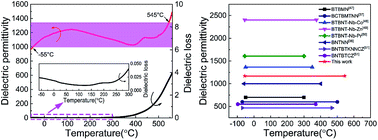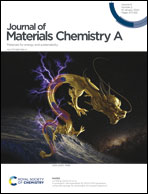High temperature lead-free BNT-based ceramics with stable energy storage and dielectric properties†
Abstract
High-temperature dielectric ceramics are in urgent demand due to the rapid development of numerous emerging applications. However, producing dielectric ceramics with favorable temperature, frequency and electric field stability is still a huge challenge. The construction of multi-phase coexistence material systems is an effective way to obtain stable dielectric and energy storage properties. In this work, NaNbO3 (NN) modified 0.95Bi0.5Na0.5TiO3–0.05SrZrO3 (BNTSZ) ceramics ((1 − x)BNTSZ–xNN) are designed to achieve the coexistence of rhombohedral and tetragonal phases. The variation in the dielectric permittivity of the 0.8BNTSZ–0.2NN ceramic is less than ±15% over the temperature range from −55 °C to 545 °C, which is the reported record-high upper operating temperature, with a high room-temperature dielectric permittivity of 1170. The 0.8BNTSZ–0.2NN ceramic exhibits excellent frequency and electric field stability as well. Additionally, a large discharge energy density of 3.14 J cm−3 is obtained in the 0.85BNTSZ–0.15NN ceramic with an energy efficiency of 79% at a high temperature of 120 °C under 230 kV cm−1, with the variation in the discharge energy density being less than ±4% in the temperature range from 25 °C to 180 °C under 120 kV cm−1. All these features demonstrate that the (1 − x)BNTSZ–xNN ceramics are promising candidates for use at extremely high temperature in both dielectric and energy storage capacitor applications.



 Please wait while we load your content...
Please wait while we load your content...